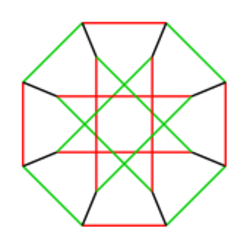Pauli group
 From HandWiki - Reading time: 2 min
From HandWiki - Reading time: 2 min

In physics and mathematics, the Pauli group [math]\displaystyle{ G_1 }[/math] on 1 qubit is the 16-element matrix group consisting of the 2 × 2 identity matrix [math]\displaystyle{ I }[/math] and all of the Pauli matrices
- [math]\displaystyle{ X = \sigma_1 = \begin{pmatrix} 0&1\\ 1&0 \end{pmatrix},\quad Y = \sigma_2 = \begin{pmatrix} 0&-i\\ i&0 \end{pmatrix},\quad Z = \sigma_3 = \begin{pmatrix} 1&0\\ 0&-1 \end{pmatrix} }[/math],
together with the products of these matrices with the factors [math]\displaystyle{ \pm 1 }[/math] and [math]\displaystyle{ \pm i }[/math]:
- [math]\displaystyle{ G_1 \ \stackrel{\mathrm{def}}{=}\ \{\pm I,\pm iI,\pm X,\pm iX,\pm Y,\pm iY,\pm Z,\pm iZ\} \equiv \langle X, Y, Z \rangle }[/math].
The Pauli group is generated by the Pauli matrices, and like them it is named after Wolfgang Pauli.
The Pauli group on [math]\displaystyle{ n }[/math] qubits, [math]\displaystyle{ G_n }[/math], is the group generated by the operators described above applied to each of [math]\displaystyle{ n }[/math] qubits in the tensor product Hilbert space [math]\displaystyle{ (\mathbb{C}^2)^{\otimes n} }[/math].
As an abstract group, [math]\displaystyle{ G_1\cong C_4 \circ D_4 }[/math] is the central product of a cyclic group of order 4 and the dihedral group of order 8.[1]
The Pauli group is a representation of the gamma group in three-dimensional Euclidean space. It is not isomorphic to the gamma group; it is less free, in that its chiral element is [math]\displaystyle{ \sigma_1\sigma_2\sigma_3=iI }[/math] whereas there is no such relationship for the gamma group.
References
- Nielsen, Michael A.; Chuang, Isaac L. (2000). Quantum Computation and Quantum Information. Cambridge; New York City: Cambridge University Press. ISBN 978-0-521-63235-5. OCLC 43641333.
External links
- ↑ Pauli group on GroupNames
2. https://arxiv.org/abs/quant-ph/9807006
 |
 KSF
KSF